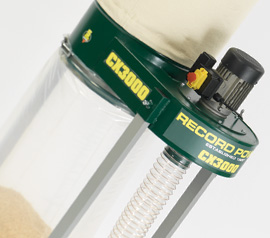Dust Extraction can be a minefield - this clear and concise guide gives an excellent overview of the benefits and suitability of all common types of extraction found in workshops.
Some hardwoods and man made materials are toxic and have been linked to serious health conditions. They also produce extremely fine dust making it essential to take proper precautions. Suitable dust extraction will significantly reduce tiny particles in the air and make your workshop a much safer place to work in.
Record Power high filtration dust extractors have been independently tested down to 0.5 microns, offering the same level of protection as a P2 respirator or dust mask and providing some of the best filtration available for this kind of extractor.
However, it should be remembered that this filtration only applies to the dust captured by the extractor. If the design of the machine does not allow for proper extraction or seals and blast gates are not properly fitted then some dust can still escape into the workshop. Always check for sound extraction design when purchasing machinery. Ensure that seals and blast gates are properly fitted and use additional protection for ultimate safety.
Dust extraction is only part of a safer working approach, so depending on your application and materials, additional protection in the form of dust masks, respirators and good ventilation is always
|
High Filtration Vacuum Extractors (High Pressure, Low Volume) Benefits |
|
|
In many ways the most versatile type of extractor – sometimes referred to as HPLV (high pressure, low volume) systems. These units rely on high vacuum pressure from industrial vacuum motors, rather than large volumes of airflow to pull dust into the machines. In these systems the air is filtered before passing through the motor and back out into the workshop. The main benefit of this system is that whilst a certain amount of airflow is required to cool the motor it does not need the large volumes required by HVLP extractors so very fine filtration can be provided effectively with a much smaller filter. Most of these kinds of extractor filter to below 1 micron as standard. And because it uses a vacuum to pull in the dust it can be used with a wide variety of reducers and hose sizes making it suitable for use with hand held power tools and benchtop machines as well as larger workshop machines. As with other types of extractor, the maintenance costs are very low as the filters and bags can be re-used many times before wearing out and are inexpensive to replace. These machines also come in a wide variety of options – from single motor drum collecting machines, ideal as a low cost solution for single applications, to larger twin motor wall mounted machines with large collection bags suitable for driving a complete workshop system. Some even offer automatic switching so that the extractor switches on as the target machine is switched on and then runs for a few seconds afterwards to clear the hoses before switching itself off.
|
|
|
Chip Collectors & Bag Extractors Benefits |
 |
|
This traditional design is sometimes known as an HVLP system (High Volume, Low Pressure). Similar to an air filter, it works by using a large powerful impeller to create a high volume of airflow which pulls the dust into the machine. It differs from an air filter because it is designed to be fed by an input hose attached directly to the dust creating machine. Dust is pulled in and generally collected in a waste bag hanging below the impeller whilst the air is exhausted back out through the top bag (above the impeller) which is where the air is actually filtered. Most commonly sold with a material bag filter (top bag) it is more accurately classed as a chip collector. Although there are differences in the filtration of the bags – in general most don’t filter down below 5 microns which is where some of the most harmful dust resides. This kind of extractor relies on large volumes of air moving through the machine to pull in the dust and the finer the filtration of the bag, the more it resists airflow and reduces the power of the extractor to shift dust.
|
|
|
Ambient Air Filters Benefits |
 |
|
These are designed to remove airborne dust from the workshop. An impeller inside the machine creates airflow which passes through various levels of filtration depending on your machine to exhaust cleaner air through the rear of the machine back into the workshop. Ideally it is best to leave air filters running all the time you are in the workshop and ideally for an hour or two after you have finished to clean the air. Air filters generally have low maintenance costs as the filters can be cleaned, so unless they become damaged it is highly unlikely they will need replacing.
|
|
|
Wet & Dry Vacuum Cleaners Benefits • Can be used as a temporary backup solution in case of emergency |
|
| These are domestic vacuum cleaners which the manufacturers recommend as suitable for use in the workshop and with wood dust. They usually come with a wide range of cleaning accessories and are relatively low cost. In essence they are HPLV systems but their default specification is for domestic dust cleaning and the filter sizes and collection capacities tend to support this. They also tend to be considerably less powerful than dedicated HPLV extractors. If you already have one then it can be a useful make-do in the short term. | |
|
Dust Extraction At-a-Glance Guide |


